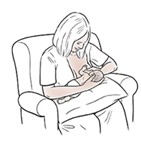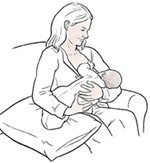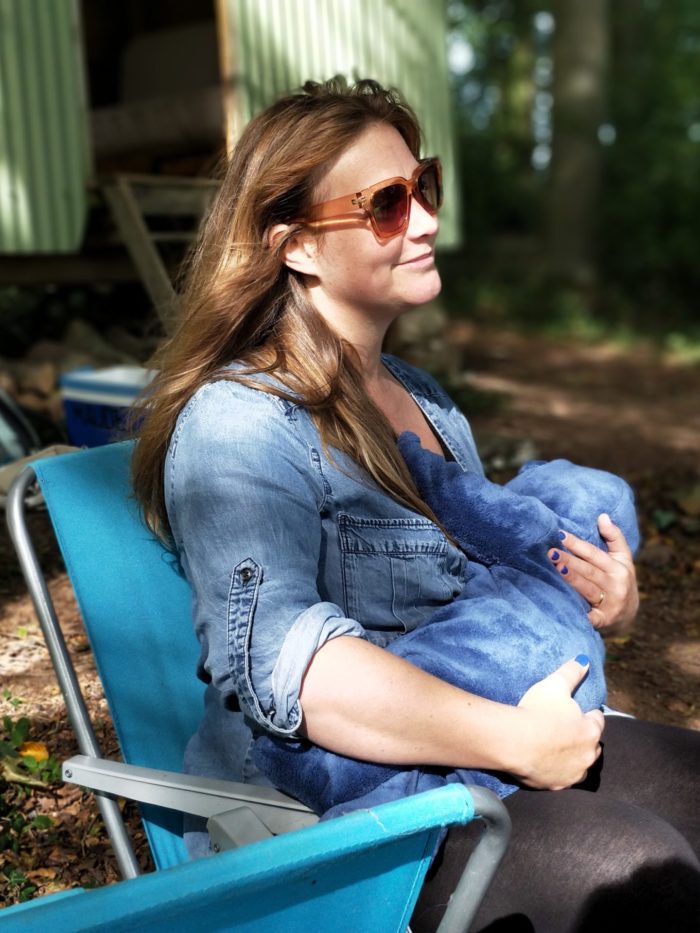Breastfeeding Basics

Human milk is the ideal choice for feeding your newborn, but it can feel overwhelming learning the breastfeeding basics. Our lactation team offers breastfeeding basics on milk supply, breastfeeding positions, latch and more, all to help guide you in your breastfeeding journey.
Benefits of Breastfeeding
Human milk is the ideal food for babies. The American Academy of Pediatrics (AAP), the American College of Obstetricians and Gynecologists (ACOG) and the World Health Organization (WHO) all strongly recommend exclusively breastfeeding for the first six months of baby’s life. Here are just some of the many benefits of human milk:
- It provides a balance of vitamins, protein, and fat that help your baby grow
- It’s easy to digest
- It contains antibodies that help the baby fight off illnesses
- It lowers the baby’s risk for having asthma, allergies and obesity
- Breastfed babies have lower rates of ear infections, respiratory illnesses and diarrhea
- Breastfeeding helps mom and baby bond.
Milk Supply
Pumping or breastfeeding as soon as possible after birth, ideally within 6 hours, helps build milk supply. Mothers who pump early, use their hands with pumping and thoroughly empty their breasts make more milk. Frequent milk removal by baby or by pumping is the best way to get a great milk supply.
*If you are experiencing latching difficulties, please seek assistance from a lactation consultant.
What is a full milk supply?
Colostrum is the first expressed milk mothers make toward the end of pregnancy or after their baby is born. It is a very small amount, drops to teaspoons, and is thick and highly concentrated in nutrients for a newborn baby’s tiny stomach.
Milk “comes in,” meaning milk volume increases, sometime between days 2-5 after the baby is born. A full milk supply is usually achieved by day 14 but may take longer with premature infants or due to certain maternal health risks. The average supply is about 25-35 ounces per baby per day.
Learn more about building an ideal milk supply.
How can I build my milk supply?
If you are unable to breastfeed or are experiencing challenges with latching, pumping can assist in milk production until you are able to exclusively breastfeed.
Use hand expression for making more milk. We recommend adding hand expression to at least 6 of your pumping sessions per day during the first 3 days.
Pump 8 times each day to start. Aim for 20 minutes of pumping (no more than 30 minutes) and allow a 4-5 hour gap at night from start time to start time. During the day, we recommend pumping every 2-2.5 hours. Once you are making 25-35oz each day (per baby), you may decrease pumping to 6-7 times per day.
Additional tips to assist with milk production include:
- Pumping at least 8 times per day
- Using a hospital grade pump if able
- Massaging breasts while pumping
- Breastfeeding, or doing skin-to-skin with your baby
- Using warm compresses, warm showers, massage, or breast compressions
Track your milk expression through our pumping log.
Breastfeeding Positions
There are many breastfeeding positions you can try to see what feels most comfortable for you and your baby, as well as which positions help baby most effectively drink milk. It is easier for your baby to position their mouth on the breast, or latch on, if they’re in a good position for feeding.
The most common feeding positions include:
 Cross-cradle. This is a great position for a newborn. Your baby’s head is supported by your hand that is opposite the breast to be used for feeding. Your hand should be positioned at the base of the head with your fingers and thumb behind the ears. You support your breast with the other hand. Baby should be belly-to-belly with you.
Cross-cradle. This is a great position for a newborn. Your baby’s head is supported by your hand that is opposite the breast to be used for feeding. Your hand should be positioned at the base of the head with your fingers and thumb behind the ears. You support your breast with the other hand. Baby should be belly-to-belly with you.
 Football or clutch. This is a great position for a mom who had a cesarean-section. Your baby’s head is supported by your hand that’s on the same side as the breast to be used for feeding. Your hand should be positioned at the base of the head with your fingers and thumb behind the ears. You support your breast with the other hand. You can place a pillow under your baby for support.
Football or clutch. This is a great position for a mom who had a cesarean-section. Your baby’s head is supported by your hand that’s on the same side as the breast to be used for feeding. Your hand should be positioned at the base of the head with your fingers and thumb behind the ears. You support your breast with the other hand. You can place a pillow under your baby for support.
 Cradle. This is an advanced breastfeeding position good for an older baby with good head control. Your baby is held in the crook or elbow area of your arm on the same side as the breast to be used for feeding. You support your breast with the opposite hand. Baby should be belly-to-belly with you.
Cradle. This is an advanced breastfeeding position good for an older baby with good head control. Your baby is held in the crook or elbow area of your arm on the same side as the breast to be used for feeding. You support your breast with the opposite hand. Baby should be belly-to-belly with you.
For all positions, bring your baby to the breast. Don’t bring your breast to the baby. Sit upright in a comfortable chair or sofa. Some find it comfortable to use a breastfeeding pillow on their lap to help raise the baby to breast level. Make sure your baby is positioned in a straight line no matter which feeding position you use; make sure their chin and belly button are in one line, meaning their head is not turned to the side. For you, being in a comfortable position means that your feet and back are supported and your shoulders are relaxed. You may find it more comfortable to put a pillow under your arm or behind your back so your arms do not get tired.
Breastfeeding FAQ
What is considered a “good latch”?
A deep latch is important for mom’s comfort and for baby to be able to remove milk well. To help your baby get a deep latch, support your breast from below with your hand as you bring your baby to your breast. Once you are both comfortable and your breast is supported, help your baby latch on correctly. Use your nipple to stroke the baby from the nose to the lower lip in a downward motion. This should trigger your baby to open their mouth wide. Then bring your baby to your breast in one quick motion. The baby should have a big mouthful of your breast, and their chin should be touching your breast. Your baby’s lips should be flanged outward like a trumpet or fish lips. The lips should not be pursed or rolled in. If you were to roll down your baby’s lower lip, you should see baby’s tongue gliding in front of the lower gum. The tongue should also cup your nipple and areola.
Baby’s latch should cover the nipple and all or part of the areola. Sometimes a baby’s latch is shallow, meaning it is not deep onto the areola. The baby may seem to be hanging on the nipple tip. When this happens, your baby won’t be able to remove milk from your breast very well, leading to long feedings, low weight gain or hurt nipples. Try the different positions outlined above if you’re worried your baby doesn’t have a deep latch, or if you have sore or cracked nipples.
If this doesn’t work, contact your baby’s healthcare provider or a certified lactation consultant for help.
Is Breastfeeding Painful?
Mild soreness or sensitivity is common for the first week or two of breastfeeding but should improve after that. There are a few things you can do to relieve nipple soreness in the early days of breastfeeding:
- Keep your nipples hydrated by using a breastfeeding-safe nipple cream or your own breastmilk.
- Wear a loose-fitting bra and clothes.
- Change nursing pads often to keep them clean and dry.
- Use only a mild soap and water to clean your breasts and nipples.
- Change positions each time you nurse.
- Prevent excessive moisture by not using plastic-backed nursing pads.
Nipples that are raw, cracked, blistered or bleeding mean that there is likely an issue with your baby’s latch on the breasts or with their ability to suck. If you feel pain with breastfeeding or are worried about your baby’s latch, contact your baby’s health provider or a certified lactation consultant (IBCLC) for an evaluation.


















